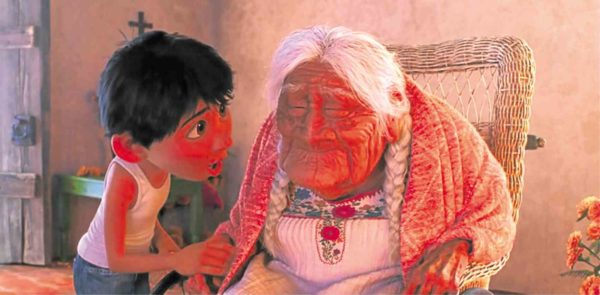Pursuing dreams, pleasing family—a ‘Coco’ dilemma
“Coco,” Disney-Pixar’s latest animated feature, creatively poses an age-old question: Would you sacrifice a potential career if your family forbade it? The answer, one boy discovers, can be found with a little help from other relatives—in the realm of the dead.
That’s the profound dilemma of a Mexican kid, Miguel (voiced by Anthony Gonzalez) who secretly studies and plays the guitar, in his secret shrine to a long-departed ancestor, who was once a beloved musician.
That person, however, must never be discussed, as he was thought to have abandoned his family—a wife and daughter—for a music career. That daughter, Coco (Ana Ofelia Murguia), is now Miguel’s great-grandmother—who is gradually losing coherence and rarely interacts with the many members of her family.
That tight-knit family continues to survive by making and selling shoes, but Miguel wishes to become a performer himself, a dream that is unthinkable to his well-meaning but myopic relatives. But, during Day of the Dead celebrations, he meets other, long-gone family members—and wonders how he crossed over to that bizarre but colorful afterlife!
Simply put, “Coco,” a film by Lee Unkrich (“Toy Story 3”), is a real tearjerker. Not immediately, but there is very relatable and familiar drama that gets to the viewer eventually, as the film insightfully and emotively talks about life and death. The fantasy-musical brings together two distinct worlds: The small-town authenticity of Miguel’s natural environment is just as painstakingly presented as the lush and luminous afterlife, populated by mostly skeletal—but still very spirited—spirits of the deceased.
The close ties on Earth, just as in the land of the departed, show how important such bonds are in the bigger scheme of things. Miguel’s lively sojourn brings to light truths that weren’t clear to him—and all the members of his clan, whether alive or dead.
What makes “Coco” important as well is its mature handling of mortality, a subject that has often been depicted, but tiptoed around in many animated films. The universality of life’s finite nature is woven snugly into the story. It’s just as interesting that the depiction of celebrating the deceased offers a look into neighboring cultures’ beliefs and rituals. The specific details may differ, but it still fits into a frame of familiarity that mortality is inevitable—but, perhaps, isn’t necessarily the end.
It’s also relevant because of its focus on the often-bound intricacies of art and fame. Miguel’s pursuit of a path as a singer-musician is reflective of common dreams, but it’s an especially contemporary thing, when many people of all ages seem bent on pursuing a path to stardom.
However, Miguel’s story, apart from the importance of loved ones and the pursuit of happiness, is about the discovery of, and respect for, artistic integrity. All these significant scenarios are somehow cohesively and coherently packaged in “Coco”—it’s a satisfying and timely adventure for the heart and mind.
